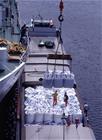European Customs Raise the Level of Security
Zhaneta Kuyumdzhieva, January 21, 2013
 Each year the European customs cross 2 billion goods, amounting to 3 300 billion euros and customs duties worth 16.6 billion euros are collected. Contrary to the common perception in Bulgaria that the customs are only a duties collection state body, in the past 40 years the EU has additionally tasked the customs aside from their obligations to ensure smooth passage of trade flows, but also to closely monitor adherence with legislation in the area of consumers protection, intellectual rights, environment, etc. In other words, the single market has created more and tough work for them.
Each year the European customs cross 2 billion goods, amounting to 3 300 billion euros and customs duties worth 16.6 billion euros are collected. Contrary to the common perception in Bulgaria that the customs are only a duties collection state body, in the past 40 years the EU has additionally tasked the customs aside from their obligations to ensure smooth passage of trade flows, but also to closely monitor adherence with legislation in the area of consumers protection, intellectual rights, environment, etc. In other words, the single market has created more and tough work for them.
After the drastic change of security requirements in the wake of 9/11 and also because of the Yemeni incident from October 29th, 2010, when two bombs made their way to two cargo planes bound from Yemen to the US, forced the European Commission as well to start thinking in the direction of improving the mechanism for risk management of the customs and the security of delivery chains. One of the first documents the Commission revealed in the beginning of 2013 is the communication for risk management of the customs and security of the delivery chains. The goals which Algirdas Semeta, a EU commissioner for taxation, customs union, audit and fraud, puts forward are related to a more rational usage of resources, improvement of quality and  availability of trade information and strengthening of partnership with traders, authorities and international partners.
availability of trade information and strengthening of partnership with traders, authorities and international partners.
According to Semeta, "Security is the most important priority for the European customs. They are the most important body for preventing dangerous goods, passing through our borders and for the safety of the European citizens. But because the character of security threats has become ever more complex in the past years, today I recommend to the member states new ways for better handling of customs risks in the future".
The flaws in the current system
Who delivers what and to whom? Ensuring information about the genuine origin, purpose and final destination of goods passing through European customs is essential for the security goals. That is why, such data should be received in advance and as early as possible electronically for identification and assessment. The current system, however, does not succeed in covering the minimum requirements for risk management with electronically filed data. In many cases, the general customs entry is not sufficiently precise to enable further assessment efforts.
Security of the entire delivery chain
The entire delivery chain is that aspect of customs service that requires high level of partnership between customs and traders. The easy identification of low risk legal trade provide opportunity for authorities to organise faster movement. For the implementation of that goal in the EU has been introduced the Authorised Economic Operator (AEO) - a programme that is monitored closely at EU level. But that system, although formally recognised by the customs authorities in the member states, if not connected to similar policies in other public areas could lead to a situation when an operator is assessed twice by two different public administrations on the same criteria. Hence the need for better coordinated efforts to expand the official recognition of AEO in other areas for the purposes of risk management, as well as to ensure benefits for conscientious companies.
Operational capacity
Not all national systems cover the minimum standards for automated analysis of security and safety risk. That is due to the capacity and technical capabilities of the electronic systems for risk analysis of the member states. The lack of 24/7 capacity and the insufficient support in some member states prevent achieving common EU standards. The trade volume and therefore workload of customs administrations varies among member states. That is due mainly to geographic situation and of course to the logistics in delivery chains. In some member states there are big discrepancies in the workload of customs officers engaged with control of risky deliveries. That workload is  sometimes 9 times bigger than EU average for air cargo and up to 50 times bigger than EU average for maritime traffic.
sometimes 9 times bigger than EU average for air cargo and up to 50 times bigger than EU average for maritime traffic.
Systemic exchange of information and more precisely the flaws in that area are another weak spot in the customs operational activities. The available data for information sharing (for a period of over 12 months) between the customs of the member states show that the existing methodologies and restructures have essential flaws in terms of identification and management of risk in external trade.
Interaction of customs with other institutions
In order to secure the process along the entire delivery chain even before the stage of customs servicing, it is necessary all competent institutions to undertake measures. Such, for instance, are the transportation of goods and especially transportation of dangerous cargo. Or to put it more generally, when customs act on behalf of other authorities or in partnership with them, the systemic exchange of information related to the risk for the environment, security, safety and health of the citizens, is very important for interception of goods entering the EU.
The new approach of the Commission
The quality of information systems for air cargo should be significantly changed  ensuring sufficient data for the cargo: the real countries along the delivery chain, adequate electronic description of the goods for the purposes of identification and risk assessment, introduction of compulsory code for trade packages, according to a harmonised system for description and coding. The identification data for cargo should be accessible for a number of countries for the sake of a more flexible usage. The sooner there is sufficient information about the analysis of the delivery chain the more efficient the requirements for control can be synchronised with the type of identified risk and adapted to the logistical process.
ensuring sufficient data for the cargo: the real countries along the delivery chain, adequate electronic description of the goods for the purposes of identification and risk assessment, introduction of compulsory code for trade packages, according to a harmonised system for description and coding. The identification data for cargo should be accessible for a number of countries for the sake of a more flexible usage. The sooner there is sufficient information about the analysis of the delivery chain the more efficient the requirements for control can be synchronised with the type of identified risk and adapted to the logistical process.
The recognition of authorised customs operators by other competent institutions and regulators in the import/export process could have essential contribution to security and could ensure dividends for the operators themselves. The same is valid vice versa too. Partial or full recognition by the customs of such a status of other authorities, for example regulated agents in air transportation, could improve efficiency of risk assessment. Technical security is also one of the tasks which the Commission document envisages. Securing it would require the member states to adapt their e-systems to common technical specifications. This includes setting aside resources for constant and high quality risk management. Some of the goals efforts on EU level should focus are:
- Adaptation of risk criteria or European risk profiles that could be applied directly on common for the EU data, not on the national systems of the 27 member states;
- Strengthening of the capacity for risk identification so that they can be treated equally at every external border;
- Improvement of data for the entire delivery chain, which will reduce the possibility such information to be ignored on the external borders of the EU;
 - Creating a platform for information exchange among customs, other institutions and nations.
- Creating a platform for information exchange among customs, other institutions and nations.
With the document, the EU calls for more coordinated actions, exchange of information, joint training programmes, partnership with operators and development of technology for improvement of the process of identification and management of risk in EU trade. Given that every minute in Europe are imported and exported 4 221 tones of trade goods amounting to 6.3 million euros, 534 customs declarations are processed and 219 counterfeit goods are intercepted, investing efforts and resources in that area will in no way be unnecessary.
 Federica Mogherini | © Council of the EU
Federica Mogherini | © Council of the EU | © Council of the EU
| © Council of the EU Luis De Guindos | © Council of the EU
Luis De Guindos | © Council of the EU